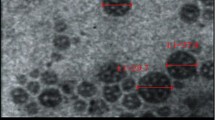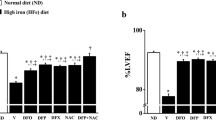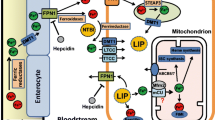Abstract
The ability of the metal ion binding rings-opened hydrolysis product of the anthracycline cardioprotective agent ICRF-187 [dexrazoxane; (+)-1,2-bis(3,5-dioxopiperazinyl-1-yl)propane] to remove iron from transferrin and ferritin, and copper from ceruloplasmin was examined. ADR-925 completely removed Fe3+ from transferrin at below physiological pH but was unreactive at pH 7.4. ADR-925 slowly removed copper from ceruloplasmin at physiological pH (68% removal after 4.8 days). ADR-925 was capable of removing 18% of the iron from ferritin in 7.0 days. All of the metalloproteins displayed saturation behavior in their initial rates of metal ion removal by ADR-925. ICRF-187 may be, in part, preventing doxorubicin-induced cardiotoxicity by depleting iron and copper from these storage and transport proteins or by scavenging metal ions released from these proteins, thus inhibiting hydroxyl radical production by iron-doxorubicin complexes.
Similar content being viewed by others
References
L. Gianni, B. J. Corden and C. E. Myers,The biochemical basis of anthracycline toxicity and anti-tumor activity. Rev. Biochem. Toxicol.5, 1–82 (1983).
B. Halliwell and J. M. C. Gutteridge,Free Radicals in Biology and Medicine, 2nd Edition, pp. 87–93, 116–117 and 487–492. Clarendon, Oxford 1989.
C. E. Myers, L. Gianni; C. B. Simone, R. Klecker and R. Greene,Oxidative destruction of erythrocyte ghost membranes catalyzed by the doxorubicin-iron complex. Biochemistry21, 1707–1713 (1982).
E. J. F. Demant,NADH oxidation in submitochondrial particles protects respiratory chain activity against damage by adriamycin-Fe 3+. Eur. J. Biochem.137, 113–118 (1983).
E. J. F. Demant and P. K. Jensen,Destruction of phospholipids and respiratory-chain activity in pig-heart submitochondrial particles induced by an adriamycin-iron complex. Eur. J. Biochem.132, 551–556 (1983).
J. M. C. Gutteridge,Lipid peroxidation and possible hydroxyl radical formation stimulated by the self-reduction of a doxorubicin-iron (III) complex. Biochem. Pharmacol.33, 1725–1728 (1984).
K. J. A. Davies and J. H. Doroshow,Redox cycling of anthracyclines by cardiac mitochondria. I. Anthracycline radical formation by NADH dehydrogenase. J. Biol. Chem.261, 3060–3067 (1986).
J. H. Doroshow and K. J. A. Davies,Redox cycling of anthracyclines by cardiac mitochondria. II. Formation of superoxide anion, hydrogen peroxide and hydroxyl radical. J. Biol. Chem.261, 3068–3074 (1986).
E. H. Herman, V. J. Ferrans, C. E. Myers and J. F. Van Vleet,Comparison of the effectiveness of (±)-1,2-bis (3,5-dioxopiperazinyl-1-yl) propane (ICRF-187) and N-acetyl-cysteine in preventing chronic doxorubicin cardiotoxicity in beagles. Cancer Res.45, 276–281 (1985).
E. H. Herman,Influence of vitamin E and ICRF-187 on chronic doxorubicin cardiotoxicity in miniature swine. Lab. Invest.49, 69–77 (1983).
E. H. Herman and V. J. Ferrans,Pretreatment with ICRF-187 provides long lasting protection against chronic daunorubicin cardiotoxicity in rabbits. Cancer Chemother. Pharmacol.16, 102–106 (1986).
J. L. Speyer, M. D. Green, E. Kramer, M. Rey, J. Sanger, C. Ward, N. Dubin, V. Ferrans, P. Stecy, A. Zeleniuch-Jacquotte, J. Wernz, F. Feit, W. Slater, R. Blum and F. Muggia,Protective effect of the bispiperazinedione ICRF-187 against doxorubicin-induced cardiac toxicity in women with advanced breast cancer. N. Engl. J. Med.319, 745–752 (1988).
J. L. Speyer, M. D. Green, A. Zeleniuch-Jacquotte, J. C. Wernz, M. Rey, J. Sanger, E. Kramer, V. Ferrans, H. Hochster, M. Meyers, R. H. Blum, F. Feit, M. Attubato, W. Burrows and F. M. Muggia,ICRF-187 permits longer treatment with doxorubicin in women with breast cancer. J. Clin. Oncol.10, 117–127 (1992).
J. Koning, P. Palmer, C. R. Franks, D. E. Mulder, J. L. Speyer, M. D. Green and K. Hellmann,Cardioxane-ICRF-187, towards anticancer drug specificity through selective toxicity reduction. Cancer Treat. Rev.18, 1–19 (1991).
P. M. Alderton, J. Gross and M. D. Green,Comparative study of doxorubicin, mitoxantrone, and epirubicin in combination with ICRF-187 (ADR-529) in a chronic cardiotoxicity animal model. Cancer Res.52, 194–201 (1992).
Z.-X. Huang, P. M. May, K. M. Quinlan, D. R. Williams and A. M. Creighton,Metal binding by pharmaceuticals. Part 2. Interactions of Ca(II), Cu(II), Fe(II), Mg(II), Mn(II) and Zn(II) with the intracellular hydrolysis products of the antitumor agent ICRF-159 and its inactive homologue ICRF-192. Agents and Actions12, 536–542 (1982).
K. M. Dawson,Studies on the stability and cellular distribution of dioxopiperazines in cultured BHK-21S cells. Biochem. Pharmacol.24, 2249–2253 (1975).
B. B. Hasinoff,The interaction of the cardioprotective agent ICRF-187 [(+)-1,2-bis(3,5-dioxopiperazinyl-1-yl) propane], its hydrolysis product ICRF-198, and other chelating agents with the Fe(III) and Cu(II) complexes of adriamycin. Agents and Actions26, 378–385 (1989).
B. B. Hasinoff,The iron (III) and copper (II) complexes of adriamycin promote the hydrolysis of the cardioprotective agent ICRF-187 [(+)-1,2-bis(3,5-dioxopiperazinyl-1-yl) propane]. Agents and Actions29, 374–381 (1990).
B. B. Hasinoff,The hydrolysis-activation of the doxorubicin cardioprotective agent ICRF-187 [(+)-1,2-bis(3,5-dioxopiperazinyl-1-yl) propane]. Drug Metab. Disp.18, 344–349 (1990).
B. B. Hasinoff,The enzymatic hydrolysis-activation of the adriamycin cardioprotective agent [(+)-1,2-bis(3,5-dioxopiperazinyl-1-yl) propane]. Drug Metab. Disp.19, 74–80 (1991).
J. M. Sisco and V. J. Stella,Is ICRF-187 [(+)-1,2-bis(3,5-dioxopiperazinyl-1-yl) propane] unusually reactive for an imide? Pharmacol. Res.9, 1076–1082 (1992).
J. M. Sisco and V. J. Stella,An unexpected hydrolysis pH-rate profile, at pH values less than 7, of the labile imide, ICRF-187: (+)-1,2-bis(3,5-dioxopiperazin-1-yl) propane. Pharmacol. Res.9, 1209–1214 (1992).
E. H. Herman, A. El-Hage, Y. Fukada and V. J. Ferrans,ICRF-187 reduces bleomycin-induced pulmonary toxicity in mice. FASEB J.3, A 275 (1989).
C. Flandia, R. Sangueldolce, L. Rausa and N. D'Alessandro,Ameliorative effects of ICRF-187 [(+)-1,2-bis (3,5-dioxopiperazinyl-1-yl) propane] on the cardiotoxicity induced by doxorubicin or by isoproterenol in the mouse. Res. Commun. Chem. Pathol. Pharmacol.70, 259–272 (1990).
A. N. El-Hage, E. H. Herman and V. J. Ferrans,Examination of the protective effect of ICRF-187 and dimethyl sulfoxide against acetaminophen-induced hepatotoxicity in Syrian golden hamsters. Toxicology28, 295–303 (1983).
A. El-Hage, E. H. Herman, G. C. Yang, R. K. Crouch and V. J. Ferrans,Mechanism of the protective activity of ICRF-187 against alloxan-induced diabetes in mice. Res. Commun. Chem. Pathol. Pharmacol.52, 341–360 (1986).
E. J. F. Demant,Transfer of ferritin-bound iron to adriamycin. FEBS Lett.176, 97–100 (1984).
E. J. F. Demant and N. Norskov-Lauritsen,Binding of transferrin-iron by adriamycin at acidic pH. FEBS Lett.196, 321–324 (1986).
C. E. Thomas and S. D. Aust,Release of iron from ferritin by cardiotoxic anthracycline antibiotics. Arch. Biochem. Biophys.248, 684–689 (1986).
D. D. Von Hoff, D. Howser, B. J. Lewis, J. Holcenberg, R. B. Weiss and R. C. Young,Phase I study of ICRF-187 using a daily for 3 days schedule. Cancer Treat. Rep.65, 249–252 (1981).
J. T. Salonen, K. Nyyssonen, H. Korpela, J. Tuomilehto, R. Seppanen and R. Salonen,High stored iron levels are associated with excess risk of myocardial infarction in eastern Finnish men. Circulation86, 803–811 (1992).
G. W. Bates and M. R. Schlabach,The reaction of ferric salts with transferrin. J. Biol. Chem.248, 3228–3232 (1973).
M. R. Schlabach and G. W. Bates,The synergistic binding of anions and Fe 3+ by tranferrin. J. Biol. Chem.250, 2182–2188 (1975).
C. J. Carrano and K. N. Raymond,Ferric ion sequestering agents. 2. Kinetics and mechanism of iron removal from transferrin by enterobactin and synthetic tricatechols. J. Am. Chem. Soc.101, 5401–5404 (1979).
R. R. Crichton, F. Roman and F. Roland,Iron mobilization from ferritin by chelating agents. J. Inorg. Biochem.13, 305–316 (1980).
K. L. Cheng, K. Ueno and T. Imamura,CRC Handbook of Organic Analytical Reagents, pp. 309–321. CRC Press, Boca Raton 1982.
E. Frieden,Ceruloplasmin: A multifunctional metalloprotein of vertebrate plasma. InMetal Ions in Biological Systems, Vol. 13 (Ed. H. Sigel) pp. 117–142, Marcel Dekker, New York 1981.
G. J. Kontoghiorghes,Iron mobilization from ferritin by α-oxohydroxy heteroaromatic chelators. Biochem. J.233, 299–302 (1986).
C. G. D. Morley and A. Bezkorovainy,Cellular iron uptake from transferrin: is endocytosis the only mechanism? Int. J. Biochem.17, 553–564 (1985).
J. Van Renswoude, K. R. Bridges, J. B. Harford and R. D. Klausner,Receptor-mediated endocytosis of transferrin and the uptake of Fe in K562 cells: Identification of a nonlysosomal acidic compartment. Proc. Natl. Acad. Sci. USA79, 6186–6190 (1982).
D. J. Yamashiro, B. Tycko, S. R. Fluss and F. R. Maxfield,Segregation of transferrin to a mildly acid compartment (pH 6.5) para-Golgi compartment in the recycling pathway. Cell37, 789–800 (1984).
G. W. Bates, C. Billups and P. Saltman,The kinetics and mechanism of iron (III) exchange between chelates and transferrin. J. Biol. Chem.242, 2816–2821 (1967).
C. L. Vogel, E. Gorowski, E. Davila, M. Eisenberger, J. Kosinski, R. P. Agarwal and N. Savaraj,Phase I clinical trial and pharmacokinetics of weekly ICRF-187 (NSC 169780) infusion in new patients with solid tumors. Invest. New Drugs5, 187–198 (1987).
J. Marriott and D. J. Perkins,Relationships between the copper atoms of ceruloplasmin II. An interaction between the copper binding sites. Biochem. Biophys. Acta117, 395–402 (1966).
L. Pape, J. S. Multani, C. Stitt and P. Saltman,The mobilization of iron from ferritin by chelating agents. Biochemistry7, 613–616 (1968).
V. N. Samokyszyn, C. E. Thomas, D. W. Reif, M. Saito and S. D. Aust,Release of iron from ferritin and its role in oxygen radical toxicities. Drug Metabol. Rev.19, 283–303 (1988).
H. P. Monteiro, G. F. Vile and C. C. Winterbourn,Release of iron from ferritin by semiquinone, anthracycline, bipyridyl and nitroaromatic radicals. Free Rad. Biol. Med.6, 587–591 (1989).
D. W. Reif,Ferritin as a source of iron for oxidative damage. Free Rad. Biol. Med.12, 417–427 (1992).
B. B. Hasinoff,The iron (III)-adriamycin induced inactivation of the respiratory chain enzyme NADH cytochrome-c reductase. Biochem. J.265, 865–870 (1990).
R. R. Crichton, F. Foman and F. Roland,Ferritin iron mobilisation by chelating agents. FEBS Lett.110, 271–274 (1980).
E. C. Theil,Ferritin: structure, function, and regulation, Adv. Inorg. Chem.5, 2–38 (1983).
G. F. Vile and C. C. Winterbourn,d1-N, N′-dicarboxamidomethyl-N, N′-dicarboxymethyl-1,2-diaminopropane (ICRF-198) and d-1,2-bis(3,5-dioxopiperazine-1-yl) propane (ICRF-187) inhibition of Fe 3+ reduction, lipid peroxidaction, and Ca-ATPase in heart microsomes exposed to adriamycin. Cancer Res.50, 2307–2310 (1990).
N. Kojima and G. W. Bates,The reduction and release of iron from Fe 3+ -Transferrin-CO 2−3 . J. Biol. Chem.254, 8847–8854 (1979).
B. L. Hauenstein and D. R. McMillan,Metal replacement studies of blue copper proteins. InMetal Ions in Biological Systems. Vol. 13 (Ed. H. Sigel) pp. 320–347, Marcel Dekker, New York 1981.
Author information
Authors and Affiliations
Rights and permissions
About this article
Cite this article
Hasinoff, B.B., Kala, S.V. The removal of metal ions from transferrin, ferritin and ceruloplasmin by the cardioprotective agent ICRF-187 [(+)-1,2-bis(3,5-dioxopiperazinyl-1-yl)propane] and its hydrolysis product ADR-925. Agents and Actions 39, 72–81 (1993). https://doi.org/10.1007/BF01975717
Received:
Accepted:
Issue Date:
DOI: https://doi.org/10.1007/BF01975717




